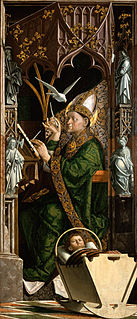 W
WRueland Frueauf the Elder was an Austrian Late-Gothic painter.
 W
WThe Master of Heiligenkreuz was an Austrian painter active at the beginning of the 15th century; a tentative lifespan of 1395 to 1430 has been put forth but this appears highly conjectural. His name is taken from a diptych that once belonged to the Cistercian Abbey of Heiligenkreuz, located in southeastern Austria near the present-day border with Hungary. The left panel depicts the Annunciation on the obverse; the reverse is a depiction of the Madonna and Child. The right panel depicts the Mystical Marriage of Saint Catherine, with Saint Dorothy on its reverse. Details of costume and iconography combine with associations with the International Style to indicate a date of around the first decade of the 15th century.
 W
WHans von Judenburg was an Austrian painter and sculptor active between 1411 and 1424. Very little is known of his life; in 1411, and again in 1424, he was listed as a householder in Judenburg. He ran an artists' studio there as well; it was devoted primarily to the creation of altarpieces. He is known to have created a retable for the high altar of the parish church of Bolzano, contracted in 1421 and finished three years later. Most of its fragments, now dispersed, survive. The center panel depicted the Coronation of the Virgin, along with John the Baptist and Vergilius of Salzburg. Various scenes from the Life of the Virgin were shown on the wings; these are now scattered around various locations, including the parish church of Deutschnofen. The hand of at least two different carvers can be seen in the work.
 W
WThe Master of Schloss Lichtenstein was an Austrian late Gothic painter.
 W
WThe Master of the Saint Lambrecht Votive Altarpiece was an Austrian painter active between about 1410 and 1440. His name is derived from a panel, formerly in St. Lambrecht's Abbey in the village of Sankt Lambrecht in Styria. This, now in the Alte Galerie in Graz, depicts a former abbot of the monastery, Heinrich Moyker, kneeling before the Virgin of Mercy; with him is Hemma of Gurk. Moyker was the donor of the altarpiece, which depicts the Hungarian victory over the Ottoman Turks. A number of other paintings are believed to be by his hand, as is the design of a stained glass window in Sankt Lambrecht; some of these have also been ascribed to the so-called Master of the Linz Crucifixion, while others are believed to be by Hans von Judenburg or Hans von Tübingen. The latter appears to have lived too late to be identified with the Master's oeuvre. Stylistically, the Master's ascribed body of work indicates a familiarity with International Gothic as practiced in Bohemia. Other stylistic traits suggest knowledge of the work being done in Cologne and Westphalia, while still others show aspects of the Viennese, French, and Burgundian schools.
 W
WMichael Pacher was a painter and sculptor from Tyrol active during the second half of the fifteenth century. He was one of the earliest artists to introduce the principles of Renaissance painting into Germany. Pacher was a comprehensive artist with a broad range of sculpting, painting, and architecture skills producing works of complex wood and stone. He painted structures for altarpieces on a scale unparalleled in North European art.
 W
WHans von Tübingen was an Austrian artist.